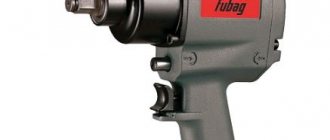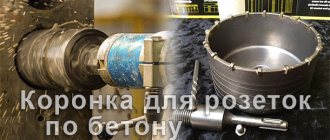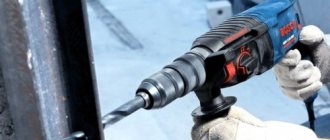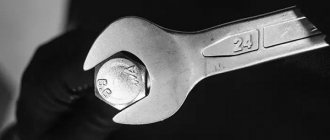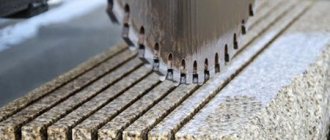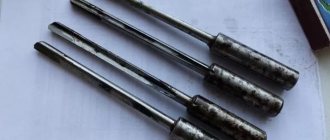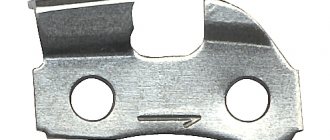You can get a high-quality large round hole in wood in a quick way. To do this, the craftsman will need a wood crown, which will allow for circular drilling. In addition to a large-diameter wood crown, you will need a regular drill and a little time.
The depth of the hole can be from several millimeters to several centimeters. To compare efficiency, it is customary to compare the results from annular drills with crowns, while the latter turn out to be 4-5 times more productive, all other things being equal. Wood drill bits are sometimes called hole saws, which largely reflects the essence of their work.
Socket box dimensions: diameter, depth, center distance
An installation box for hidden installation, designed for mounting a socket in it, is called a socket box.
Most often, the socket box has a round shape (less often square) and a standard size. The main function of the socket box is to provide a rigid and reliable mounting location for the socket inside the wall, near the plane of its surface. If you need to install a socket box, then armed with quite ordinary tools (pencil, level, spatula, brush, hammer, chisel, drill with a crown, alabaster), you can do it yourself. Follow safety precautions, first turn off the electricity supply in the panel, use the tool carefully, remember the standards - and everything will work out.
Installation of a socket box
First, make markings regarding the wire going to the future outlet. Draw a horizontal line at a short distance from the wire - this is the level of the center of the future socket, then draw a vertical line - this will be the edge of the socket box (the wire will have to go from the top to the side), finally apply the socket box and outline it with a pencil - mark the place for drilling.
The standard diameter for drilling with a crown is 68 mm, and the depth will be approximately 45 mm; this should be taken into account when choosing a crown. In general, the attachment for a drill is called a “crown for a socket box (they are available for concrete, wood, etc.), so there will be no problem purchasing it. Drill according to the markings, if necessary, during the drilling process moisten the nozzle with water so that it does not overheat too much.
The socket box is fitted to the hole and the remaining drilled material is removed using a chisel and hammer.
If a single socket box is installed, then the transition lugs from its edges are cut off so that they do not interfere with installation in the mounting hole, but if there are several sockets nearby (a block of sockets), then the necessary lugs are left to fasten several socket boxes to each other.
If the socket fits easily into the mounting hole, everything is fine. The wire should easily fit into the diagonal hole of the socket box, which is located on the side near its back wall.
When the socket fits normally and is suitable in diameter and depth, the hole is moistened with water so that the alabaster adheres better, then the solution is mixed. The solution is prepared at a ratio of 4 to 1 - 4 parts alabaster to 1 part water. Apply the solution to the socket box from all sides in contact with the wall.
Carry out the installation, position the socket box strictly in the plane of the wall so that it does not stick out or go too deep, the edges of the socket box should be at the same distance from the edges of the mounting hole. The remnants of the alabaster solution are used to mask the wire going to the socket box.
Drilling walls for socket boxes in the video:
Installing a new socket in an old socket box
Sometimes, when carrying out repairs in multi-year-old houses, it turns out that the old metal socket box is much wider than necessary, the new socket dangles in it like in a bucket, the legs do not catch. In this case, you can put a new socket box directly inside the old box.
A hard, wide old box without a bottom will require the use of alabaster mortar, as is the case when installing a socket box in a wall. If the box firmly holds the new socket box, then it is simply screwed onto the old one with self-tapping screws, remembering that the wire must be inserted from the back side and not damaged by the screws.
Block of several socket boxes
If several socket boxes are placed in a row, then this is done by mounting a block of socket boxes. The crown is taken with a slightly larger diameter - more than 68 mm, up to 80 mm - the mounting holes will be combined with each other, and the interaxial distance will be at least 71 mm.
They make a horizontal marking relative to the wire that will have to go from the right, then they mark the wall for drilling mounting holes, taking into account the required center distance or along the already connected socket boxes - simply circle the block.
They drill holes, remove the excess with a chisel and hammer, remove the partitions, and run the wire horizontally. The margin in diameter will help to orient the block evenly. The transition lugs perform their function here - they combine the socket boxes into a block.
Installing a socket box in drywall
Universal socket boxes for drywall have special spacer lugs that make fixing easier, and alabaster is not needed with them. A hole is drilled with a crown to suit the size of the socket box, installation is carried out, fixation is carried out with a screwdriver - that’s all. When tightened with a screwdriver, the fastening lugs expand and hold well inside thin-walled surfaces such as drywall.
The universal socket box has a distance between the fixing tabs of about 83 mm, so if a switch or socket has a larger distance between the fasteners than usual, such devices will fit well. Also, universal socket boxes can, in principle, be screwed to wood or placed in concrete by simply removing the fixing tabs.
Which is better: heated floors or radiators?
Warm floorBatteries
Installation under plaster or tiles
If the wall will be plastered or tiled in the future, this must be taken into account when installing the socket box. Make a margin of about 7 mm for the protrusion (or as much as the covering will be) so that the plane of the future wall covering coincides with the edge of the installed socket box. Thus, the socket box must be left protruding.
In general, when installing a socket box in the wall in advance, it is important to take into account the fact that it is possible that the depth of the future socket (switch) and its diameter will differ from the geometric parameters of the socket box.
The wire in the socket box must have a reserve
Despite the seeming insignificance of this aspect, a prudent installer always takes into account the fact that it is likely that in the future, when replacing an outlet or switch, it will be necessary to strip the wire or shorten it slightly. If the wire turns out to be short, then it will have to be extended, and this will be associated with increased vulnerability of the connection; it will oxidize and break faster, and will spark.
The wire is taken with a margin of about 20 centimeters, carefully twisted into a spiral or smoothly (not steeply) bent, and thus compactly fits inside the socket box. This is done, of course, so that if in the future the owners decide to update the interior, they can easily update the sockets without unnecessary hassles and problems with extensions. How to extend a short wire if the wall, say, is covered with tiles or plaster? It's easier to leave a reserve in advance.
Share this article with your friends:
Join our groups on social networks:
Tungsten carbide
The main part is abrasive tungsten carbide coating . The chips on the edge of the cutter are so strong that they cope with such stubborn materials as ceramic tiles .
The ideal type of nozzle if you need to make a recess for a socket box in a tiled wall . You can work with brick and stone. The only disadvantage of the products is that the service life is much lower than that of a diamond crown.
You cannot drill through reinforced areas , as the cutting edge will become jagged and unusable .
How is the crown constructed?
This type of drilling tool is an attachment for a hammer drill or impact drill. The appearance of such an assembled and ready-for-drilling structure is presented below.
A crown for reinforced concrete installed on a hammer drill powered by 220 Volts
Now let's look at how the drill bit is structured; its main elements are shown in Figure 2.
Designations:
- A – cartridge, this is the nozzle on which the remaining structural elements are attached.
- B – centering drill for concrete, ensures the correct shape of the hole. This element, like conventional drills, becomes dull over time and therefore needs regular replacement.
- C – the crown itself, as can be seen in the photo, is a piece of pipe on the edge of which cutting segments are installed (marked with red circles). They are made from special carbide materials capable of cutting stone, brick and concrete. Crowns can be of different sizes; they are selected depending on the required width of the hole. Dry drilling attachments are sold in sets or individually. Assembling the tool is quite simple and does not cause any difficulties.
Both electric and pneumatic tools of appropriate power can be used as a drive; in some cases, special drilling rigs are used.
Application of drilling tools
The last two types are, as a rule, not used when installing hidden household wiring at the amateur level.
How to sharpen a wood crown?
With active use, drills can become worn down and require sharpening. You can restore the sharpness of a wood drill bit yourself, but this will require certain skills. Maintaining the sharpening angle is an important point, without which it will not be possible to properly restore the functionality of the drill. Core drills for wood are made of soft metals, and they can be restored using hand tools and tools, for this the following are used:
- Grinder with a special grinding disc.
- Hand drill with sandpaper disc.
- Sharpener or emery machine.
Review and description of the main types of crowns
To effectively cut holes in, it is important to choose the right bit based on the material in which the drilling will be carried out. Depending on this, the type of crown is selected, which is determined by the type of cutting attachment. The following edges are used for concrete, stone and brick partitions:
- Diamond.
- Tungsten carbide.
- Pobeditovye.
Let's talk in detail about each type.
Diamond
The peculiarity of this tool lies in the technology of non-impact drilling. With this method, a more correct hole geometry is obtained than when cutting with a carbide-tipped tool.
Holes drilled with a diamond bit (A) and a carbide bit (B)
There are two concrete drilling technologies: “wet” and “dry”. Accordingly, different types of crowns are used for each of them.
Wet cutting tool.
In such crowns, the cutting part consists of diamond tips soldered to the base with refractory solder. If cooling water is not supplied to the edge during the cutting process, the nozzle will quickly heat up to a threshold temperature (about 600°C), after which the tool will fail.
A crown of this type that has become unusable can be restored, despite the fact that this is an expensive process, its cost will be lower than the price of a new instrument.
Dry cutting tool.
When making crowns that do not require forced cooling, the cutting attachments are welded to the base using a laser. Such a tool may be subject to a higher thermal load, but, unfortunately, if it fails, it cannot be repaired.
Rubi Foragres bits for dry cutting of concrete
Advantages and disadvantages of diamond-coated hole cutters.
Let's start with the undoubted advantages:
The main disadvantage of diamond bits is their high cost, which can be offset by the possibility of restoring the tool. But this is only available for wet hole saws. To work with such crowns, a special drilling tool is required, which does not make sense to buy for the sake of drilling a dozen or two holes. This is a professional level technique.
“Dry crowns can be used with a conventional hammer drill in non-impact operating mode. But this requires a certain skill, the tool is quite fragile, if vibration occurs (for example, when the support drill is rotated), the cutting attachments may break off. Such a crown cannot be restored.
Tungsten carbide
This type of cutting coating allows you to work with brick, concrete and ceramic materials (for example, tiles). If such a cutter encounters metal fragments, it almost always fails, that is, such a tool is not suitable for cutting reinforced concrete.
Pobeditovye
This is the most common type of hole saw. Its main feature is that teeth made of pobedite or other hard alloy are used as the cutting material.
Core cutter with carbide inserts and SDS shank
For this type of tool, a percussion drilling method is provided, that is, it is intended for use in conjunction with rotary hammers. Accordingly, the shank of such bits is made for an SDS chuck (SDS+ and SDSMAX options are possible).
The main advantage of such a drill is its low cost. As for the disadvantages, these include:
- Rapid tool wear.
- Impossibility of restoring cutting attachments.
- Failure upon contact with metal fragments (reinforcement).
Despite a large number of disadvantages, tools with carbide tips remain in demand due to their low cost.
Preparatory operations for work
It must be taken into account that to prevent rotation, manufacturers create an irregularly shaped socket for fitting the tool. More experienced specialists remind you that for high-quality fixation it is necessary to tighten the thrust nut or bolt well. This will allow the cutting tool to be securely held in the grooves and not to become loose, deforming and bending the hole.
Example of the resulting hole
It is necessary to install the tool into the drill chuck only after all threads have been tightened. Then you can start drilling at the selected point. The process is practically no different from working with a classic drill. It is important during the operation to maintain maximum perpendicularity to the axis of rotation of the plane being treated. This factor is maintained in the first millimeters, then everything goes along the initially formed cylinder.
The number of revolutions for rotating the crown is also set in advance. It is worth considering that an increase in the diameter of a tool is combined with an increase in its vibration. This forces the use of more powerful drills if you take wood drills for large holes and large diameters. If possible, attach an additional handle to support and maintain perpendicularity.
When setting the rotation speed on a drill, you need to follow these rules:
- soft wood can be processed at speeds from 1000 (diameter 3.0-5.0 cm) to 2400 rpm (diameter 10-55 mm);
- for hard wood, it is advisable to increase the speed to 250 rpm (3.0-5.0 cm) to 600 rpm (1.0-1.5 cm);
- When using bits with carbide tips, you cannot lower the speed below 400-500 rpm, as the cutting edge will crumble.
VIDEO: How to drill a large diameter hole
Socket sizes
The standard for a “glass for an internal socket or switch” is a diameter of 68 mm. Naturally, for cutting it is better to select a larger hole saw, for example Ø 70 mm, 72 mm and even 75 mm. Accordingly, a crown with a diameter of 65 mm is not suitable for this purpose (if you use standard sockets).
Standard diameters.
Conventionally, core cutters are usually divided into four size groups:
- Small diameter tool. This includes cutters Ø4.0 – 12.0 mm. In everyday life, such attachments are practically not used. Their scope of application is electrical switching work of increased complexity.
Please note that to use cutters of the third and fourth groups you will need special drilling rigs.
Recommendations for selection
Let's start with the fact that the only thing better than a diamond crown is a high-quality diamond crown. But given the cost of such a tool, the question arises about its profitability, especially if it is necessary to drill 10=20 holes. In such a situation, it is economically justified to purchase 3-4 Chinese drills. On the other hand, purchasing a set of diamond cutters of various diameters can be considered as an investment in private ownership of the means of production.
Once you have chosen quality, stick to the principle until the end. Well, good diamond crowns for concrete sockets cannot be cheaper than Polish Pobedit cutters of average quality.
When working with concrete surfaces, there is often a need to create large-diameter holes, in particular for installing socket boxes or laying communications.
- How is it structured?
- Overview of species
- Which one is better to buy?
- Prices
The nozzle is a piece of pipe equipped with cutting edges on one edge and a flange for fastening; the kit sometimes includes a centering drill, which is necessary for more reliable fixation. Standard crown dimensions for a socket box: diameter 68 mm (in rare cases less, maximum - 74), the length of the working part depends on the required drilling depth (minimum - 50). This type of cutting device can be used as an attachment for a drill only if it has high power (from 800 W) and a suitable head diameter. But in general, it is better to choose a special drilling tool: pneumatic or electric.
A special feature of concrete crowns is the presence of sharp cutting edges: from 6 to 16 pieces, which ensure accurate and fast work. For comparison, when using a conventional drill with a standard drill with a diameter of up to 12 mm, you will need to drill at least 12 holes and gouge out crumbs from the future socket box. When choosing a crown, the desired recess is drilled in a maximum of 5 minutes, the edges remain intact and perfectly smooth. This is achieved due to high tool speeds.
Socket box for drywall
Before installation, it is necessary to remove the plugs in the cable entry area. In this case, a wire with optimal parameters is selected in advance. The optimal dimensions of the element are also important, and therefore the diameter of the product is taken into account when choosing. The most common standard parts are with a diameter of 70 mm. They are suitable for simple sockets, but for a stove you should choose a special device.
In the field and other Sciences are constantly being developed. Every year scientists from around the world make a little opening, slowly moving humanity forward and improving our lives. Explores untouched by man places, first and foremost, of course, on our home planet. However, in the space constantly undergoing work. The distance from the slope to the first outlet in the group should be 150-200mm, and be the same in all rooms.
It is almost impossible to accurately measure these distances before leveling the walls with plaster, therefore the ideal option is to postpone the marking and installation of socket boxes to the moment when all the walls have already been formed. When placing only the socket mechanism in the socket box, you should choose elements with a depth of 45 mm for standard devices. If you plan to install electrical wiring in the socket box, then more spacious options are needed.
In this case, shape plays an important role. Round options are often used, which are easy to install. There are also square models that are optimal for installing non-standard mechanisms or for obtaining more space.
Installing socket boxes in drywall: tips for a novice master
The socket box for gypsum boards is an important element when installing electrical equipment into hollow walls, which is securely attached to the sheet and allows you to mount any electrical structures - switches, sockets, sensors or switchers. Important! When installing several socket boxes in one line, it is necessary to maintain a distance between their centers of 71 mm. When planning to mount a socket box in plasterboard, it is important to be able to choose it correctly. Of course, in any hardware store, consultants can help with the choice, but it is better if you yourself know what the differences are between socket boxes and how not to make a mistake with the purchase.” A glass for drywall differs from the rest in the presence of special fasteners installed on screws. These fasteners secure the socket box to the inside of the wall.
This is the only way “the glass can be securely fixed – neither with putty solution nor with cement. There are times when it is necessary to install 2 or 3 socket boxes in a row. In this case, you need to select “glasses with connecting tunnels through which the wire will be laid. If you only need to install one socket box, these connections can be cut, as they may interfere with installation in the recess in the drywall. There is a second option - you can purchase special connecting elements.
These partitions are installed in the glasses immediately before they are installed in the wall.
How to choose crowns for socket boxes on concrete, plasterboard, wood
To drill a hole for the socket box, you will need a crown and a tool with an electric or pneumatic drive. If you plan to drill drywall or wood, it will be enough to use an electric drill. It is better to use a hammer drill on a brick, stone or concrete wall. The impact force when drilling should be approximately 14 J.
In other words, if you take a 1.5 kW hammer drill, the tool will cope with the task without any problems. When working with drywall, you can use another type of cutter - bimetallic. In addition to gypsum boards, they can be drilled into wood, plastic, and sheet metal. In general, a bimetallic cutter is used to cut a socket for a socket box in any fragile finishing material.
The center drill and shank are often sold as one set with an attachment. There are also extension cords designed for rotary hammers with different cartridges: SDS Plus or SDS Max. The extensions have standard threads similar to those on the crown body, so they are easy to change. The center drill can be cylindrical or conical. The standard bit is usually supplied with a cylindrical drill bit, while the extended shank may be sold with a tapered drill bit.
Regardless of the type of socket box, their standard diameter is 68 mm. It is to this size that most manufacturers make sockets, switches and regulators. Naturally, in order to drill a socket of the appropriate size, you need to take a similar diameter of the crown - 68 mm. Sometimes circumstances require making a larger hole, for example, in a concrete wall, where the socket box will be secured with concrete mortar. Here it is possible to use crowns whose diameter is increased to 70 or 75 mm.
It is rare to find glasses from Chinese manufacturers of non-standard sizes on the market. The diameter of the crown for them will have to be selected experimentally.
Crown structure
A standard crown consists of the following elements:
- Shank . Fastening for inserting equipment into the chuck of an electric tool.
- Centering drill . The main guide for creating holes.
- Cutting attachment . A cylindrical “blank” with a jagged end.
Core drills with countersinks allow you to deepen the outer edge so that the socket box does not protrude even a millimeter above the wall surface.
Manufacturers produce cutters of two design types:
- Collapsible . All elements can be removed and any of them replaced.
- Non-separable . If something breaks or wears off, just throw it away.
According to the type of fastening, cutter shanks are divided into: triangular , hexagonal , SDS Plus and SDS Max . Before purchasing, you should find out which ones your hammer drill can work with.
Types of crowns for drilling holes in drywall
During renovations, you often have to face the need to make a hole in the drywall to install socket boxes, spotlights or switches. The simplest option may be a drill bit with a drill bit. Such equipment allows you to make the necessary holes of the required diameter with a perfectly even cut.
What crowns are most often used and how to choose a high-quality attachment?
- The attachments allow you to drill into material up to 22 millimeters thick. Considering the parameters of the plasterboard sheet (thickness 14.5mm), this set is perfect.
- The holder is also different; it has protrusions for securely fixing the cylinders and a centering drill.
- Fix the nozzles using a hexagon.
- Professional sets are sold in hard plastic cases and have several holders, spare drills and sets of crowns with sizes from 38 mm. Wood crowns
The second name is a wood saw. The nozzle is designed for cutting large diameter holes. Kits are available for sale, consisting of an adapter for cylindrical nozzles with various diameters and a centering drill. Drilling holes in drywall One of the features of drywall sheets is that they are easy to machine. To drill it, you can use various types of crowns designed to work with harder materials. Set of bits for plasterboard and wood To obtain holes of the required diameter in plasterboard surfaces, you can purchase the following types of attachments. It is worth knowing that sets of inlaid drills mainly come in two varieties: the first from 23 to 63 mm, and the second from 63 to 100 mm. Drills for wood at work You need to select them in accordance with their intended purpose; if it is an opening for a socket box (68 mm), then it is worth buying the second option. The price for a good set ranges from 200 to 400 rubles. On average, a set costs 200 rubles.
It is better to immediately ignore the offered attachments at a more favorable (read cheaper) price.
Features of crowns for socket boxes on plasterboard
- Material of manufacture: must be self-extinguishing plastic. If the outlet gets hot, the heat won't be able to transfer to the drywall. This will help prevent short circuits.
- Individual sizes, when the distance between the wall and the covering is small. If the width is standard, you can purchase models of standard sizes with a depth of 50 cm.
In order for the installation of socket boxes in plasterboard to be successful, preliminary preparation of the walls should be carried out. At the preparatory stage you need: Crown - a special drill in the form of a cylinder with an edge that has small but sharp teeth. With its help, you can effectively drill material, obtaining perfectly straight holes. Standard product sizes are 68-70 mm, but there are nozzles with other parameters. After the tool and the hole itself are ready, installation work begins.
It is recommended to familiarize yourself with the electrical wiring plan, taking into account the arrangement and overall dimensions of the furniture. It is better to spend a little time and get the necessary information than to redo everything later. Modern devices have additional fasteners with which they can “clip to the installation cover, ensuring optimal fixation of the connector.
Diamond
The active element of diamond crowns is a coating of natural mineral, which has no equal in hardness. Strong segments are laser welded on the edge of the cutter. They quickly cut concrete using fine diamond chips generated during operation.
Types of marking: M - only ordinary concrete, C - reinforced, T - high-quality.
The equipment is suitable for reinforced sections of walls, as it can easily handle metal. The cutter penetrates to any depth, leaves smooth holes and creates a minimum of noise.
Diamond bits are not designed to work in impact and combined modes. Set the rotary hammer switch to “ drilling only .
Drywall crown 68 mm: types, characteristics, nuances of application
Bimetallic cutters are also produced, which, in addition to processing fragile materials, are suitable for drilling metal and steel with sheet thicknesses of 1 mm or more. Popular manufacturers that produce 68 mm crowns include the brands Bocsh, HSS, Sigma, MTX, etc. The Karat (Bosch) series cutter is used complete with an adapter and a centering drill, which allows you to process plasterboard walls, marble and wood. The HSS bit (Makitta) chambered for 13 mm is suitable for processing surfaces made of gypsum plasterboard, plastic, plywood and chipboard.
Allows you to make holes in the wall with a depth of 3.2 cm. It is equipped with a countersink. Before choosing the installation method, prepare a tool, in addition to crowns and sockets, use a drill, a screwdriver and the outer part of the socket. This type of installation is the simplest.
It is used if there is a metal frame, and on sheets of plasterboard you can confidently determine where the profiles are located based on the marks left by the screw heads. There is no risk of snagging wiring or getting into the middle of the profile when making holes, which guarantees safe installation. For sockets, a special cylindrical drill (mill) is used with a cutting edge in the form of pointed teeth placed at a certain angle at the end.
In the center of the device there is a drill around which the crown is placed. First, a drill penetrates the material being processed, fixes the nozzle in a given position and performs alignment for the cutting edge. This shape is optimal for efficient drilling and durability of the crown. I will tell you about all the options that can be used for drywall, I have tested each of the types described below in practice, so you can safely take this information into service.
And don’t worry - the work process is not complicated and can be done with your own hands even by someone who is holding a drill or screwdriver in their hands for the second time in their life. First, mark a horizontal line at the required height from the floor level. To do this, we use a tape measure and a simple pencil. Then we determine the location of the socket boxes , taking into account the symmetrical location of the structure relative to all sections of the wall.
After these manipulations, four points appeared on our wall, which define the central part of the socket boxes. Now you can start drilling holes.
- choose socket boxes for plasterboard made of self-extinguishing plastic. When the outlet heats up, the heat from it will not transfer to the surrounding drywall. This is additional safety in case of a short circuit;
- focus on individual dimensions if the distance between the main wall and the plasterboard covering is small. If the width of the cavity is sufficient, you can buy a model of a standard size - 50 mm deep.
Diameter of crown for socket box in plasterboard
A socket box for plasterboard is a plastic or metal mounting box necessary for securely fixing electrical installation equipment and isolating it from flammable materials in a hollow wall. If you only need a crown for sockets, then there is no point in purchasing a whole set; you can buy a special crown, which most often has diameter 68 or 70 mm for standard socket boxes. The cost of a separate device will be from 300 to 600 rubles. A socket box for gypsum boards is an important element when installing electrical equipment into hollow walls, which is securely attached to a sheet and allows you to mount any electrical structures - switches, sockets, sensors or switchers.
Sometimes it happens that the calculations are made incorrectly and after drilling in the hole for future sockets, a profile is visible, due to which it is impossible to push the block through and securely fix it in the recess. In this case, the crown is replaced with an ordinary metal knife or chisel and the holes are made manually, removing 5-10 cm of the visible profile. The frame of the structure will not suffer from this, but the sheet of drywall itself may be deformed, and due to the inconvenient viewing angle there is a risk of injury.
When cutting the profile, it is recommended to wear special installation gloves - they will protect your hands from unwanted cuts.
How to treat the surface → Room decoration → How to choose the right paint → Surface treatment technologies → Leveling and finishing the walls → Selecting and applying a primer → Removal from the surface → Stretch ceilings and technologies → Reviews and testimonials
Carbide
The cutting part of carbide bits is brazed from an alloy called “win” ( 90 % tungsten and 10 % cobalt). The main advantage is low cost, and the main disadvantage is the short service life. Such cutters are very vulnerable and must be treated with care.
This is the right choice if you need to make 1 - 10 holes for socket boxes in concrete or brick walls. The products are not suitable for large volumes.
When it comes into contact with reinforcement, strong teeth are broken out of the “blank”, especially in products made in Asia. Therefore, you should avoid reinforced areas .
